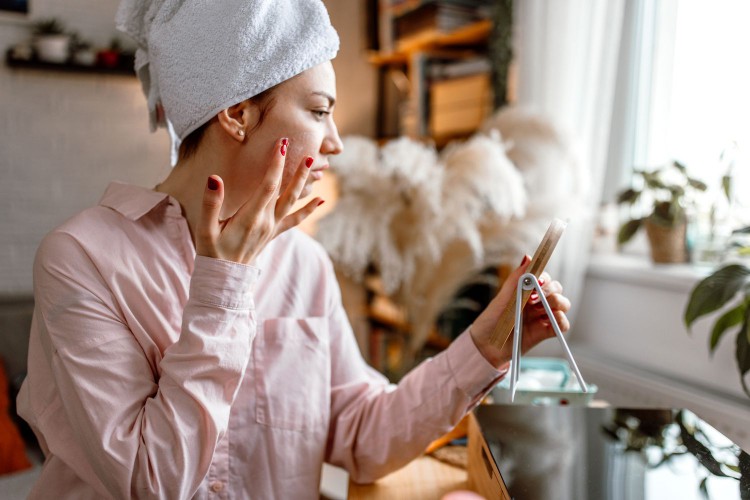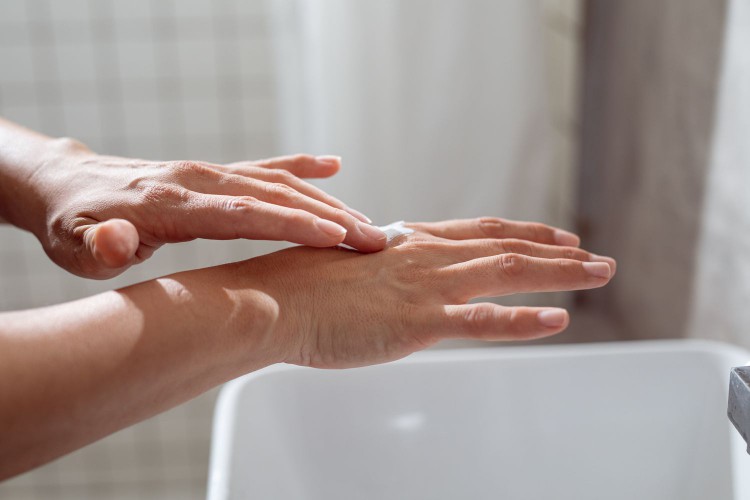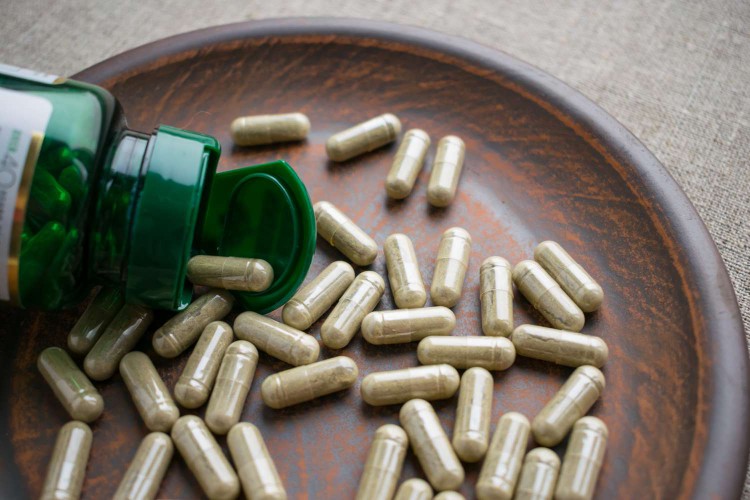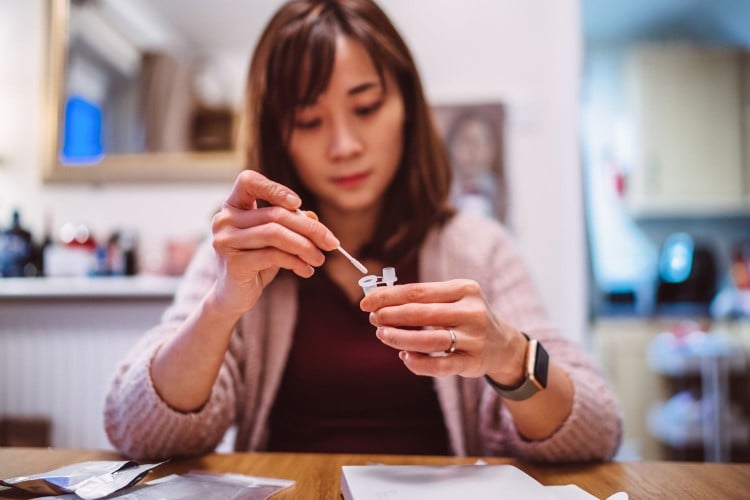Starting Retinol: 5 Things to Know, According to Dermatologists
- Retinol is a popular skincare product that works to reduce fine lines and wrinkles, acne, and discoloration.
- The ingredient has some side effects, the most common of which is "skin purging" where the skin experiences breakouts before it begins to see the positive benefits of retinol.
- Experts recommend starting out slow when adding retinol to your skincare routine, to help skin adjust in a safe, healthy manner.

J_art/Getty Images
Before you add retinol to your skincare routine, there are a few things dermatologists want you to know.
Retinol products are fairly popular, particularly in the anti-aging space.
“Retinol is a derivative of vitamin A; it is in the same family as retinoids, but retinol is a milder, more gentle formulation that can be obtained without a prescription,” Rebecca Bialas, MD, MPH, co-founder of CLARA Dermatology, told Health.
She explained that retinol use is often in the form of a serum or cream that works to treat fine lines and wrinkles, discoloration, acne, and clogged pores.
These benefits are due to the ingredient's ability to increase collagen, which directly impacts the skin's appearance.
“Retinol boosts the production of collagen and elastin, reducing the appearance of wrinkles and fine lines,” Ava Shamban, MD, board-Certified dermatologist and founder of AVA MD Dermatology and SKIN FIVE Medical Spas, told Health. “Retinol increases cell turnover, exfoliating the skin which clears clogged pores. This minimizes breakouts.”
That said, starting retinol treatments can come with some side effects—it's not uncommon for skin to "get worse before it gets better" once someone begins using retinol.
Here's how to begin safely taking retinol, side effects you need to be aware of, and how to choose the right retinol product for your skin.
Most People Can Use Retinol
According to Bialas, a common assumption about retinol is that if someone has very sensitive skin, they can never use a retinol.
But, retinol can actually be helpful for most people.
“We can typically get most of our patients using a retinol, even those who are sensitive, but it takes time and patience to begin using retinols correctly—the exception here is patients with severe rosacea or extremely sensitive skin,” Bialas said.
She explained that when someone begins using retinol, they may experience drying or irritation. Starting slowly, with one or two nightly applications a week, allows the skin to ease into retinol use.
“When you're first starting to use a retinol, start 2-3 times a week, or once a week if you're super sensitive. After you've tolerated that frequency for a few weeks, try increasing slowly, maybe to every other night,” Bialas said. “Eventually, you can work up to applying a retinol nightly, but it can take months to get there.”
Anti-Aging Skincare Products You Should Have in Your Routine, According to Dermatologists
A Small Amount Will Do
It's worth noting that a little bit of retinol goes a long way.
“I tell my patients to put a pea-sized amount on their index finger, and then use that to make five smaller dots around their face: forehead, nose, each cheek, and chin,” Bialas said. “Then, gently rub in those smaller dots to ensure that you're getting a thin even coat everywhere, avoiding the eye area.”
Bialas and Shamban also recommend people combine retinol with a hydrating nightly moisturizer to help combat skin sensitivity.
“Typically, after you wash and dry your face, you can apply the retinol and follow with a moisturizer. Some people who are more sensitive might benefit from flipping this order, however (apply your moisturizer, then the retinol on top,” advised Bialas. "This is another way of minimizing the irritation that can happen as you are getting used to using a retinol.”
Different Skin Types May Need Different Retinol Concentrations
As with most beauty and health products, different skin types will need different concentrations or levels of retinol. The strength of the retinol you need will also depend on your skincare goals.
Bialas explained there are two kinds of retinol: prescription-strength and off-the-shelf products. OTC retinol products come in different strengths, the main ones being 0.25%, 0.5%, or 1%.
“If you have acne, you will likely need a stronger formulation—typically a prescription-strength retinoid," she said. "If your goals are to brighten skin and stimulate new collagen production, an [OTC] retinol is generally the right strength for you."
Shamban suggests patients with sensitive skin start with a very low retinol concentration.
“I recommend using a retinol with a concentration of 0.25% to 1%," she said. "If you have sensitive skin, the lower concentration the better."
How To Tell If Your Skin is Purging or Breaking Out
'Skin Purging' Happens, But It Won't Last Forever
As mentioned, retinol use does come with side effects that are worth paying attention to.
Most commonly, retinol can sometimes make your skin look worse before it gets better. This phenomenon is known as “skin purging.”
Bialas explained that skin purging occurs because retinols increase the speed of skin cell turnover, so any oil and debris trapped in your pores is brought to the surface.
“Sometimes, this looks like a breakout—whiteheads or new pimples can appear on the skin," she said. "Don't think of these as totally new breakouts though; typically, these are pimples that have been brewing beneath the surface and would have appeared over time anyway."
Bialas noted that skin purging doesn't happen to everyone who starts using a retinol product. But if it does happen, it typically takes 2-4 weeks to clear up.
You May Need to Experiment With Different Kinds
The best way to choose a retinol product that is right for you is to get a skincare consultation from a board-certified dermatologist for a skincare consultation. These doctors will be able to take into account your skin type, and how retinol will fit into the rest of your skincare regimen.
Shamban noted that picking the best retinol for your skin may also take some experimenting.
“It is a process that may involve testing different treatment protocols, depending on type and stage of acne, as well as the age of the patient and the patient history to see what is the key to controlling the skin," she said.
It's also worth understanding how retinol products may vary depending on ingredient list.
Bialas explained that retinols are sometimes combined with other skincare ingredients like AHA or BHA acids, but she typically advises her patients to use a product where retinol is the only active ingredient.
“If you are using a product that contains retinol along with other active ingredients, you increase the risk of irritation to your skin, or at the very least, you will not get to use those other ingredients as often as you may want since you are ramping up so slowly on the retinol itself,” she said.
Her one exception to this "rule" is when hyaluronic acid is combined with a retinol.
“Hyaluronic acid can help the skin to retain moisture and potentially make the retinol more tolerable and less drying to the skin," she said.
Be Patient—Change Takes Time
It typically takes a few weeks for your skin to adjust to a retinol product. During that time, you might have some skin irritation, but it should even out after a few weeks.
“Some redness, dryness, and flaking can be normal even when retinols are applied carefully and you start slowly," Bialas said. "If the irritation becomes too intense, skip a few applications and allow your skin to calm down, and then resume at a slower pace."
She reiterated that retinol is a product that works for long-term skin health, and it may take longer than you'd like for progress to be clear. That said, results will come eventually, generally after 3-6 months on consistent use.
“Remember, you are playing the long game here," Bialas said. "With proper use, you can use your retinol for the rest of your life and continue to see the benefits in the form of brighter, clearer, firmer skin.”








